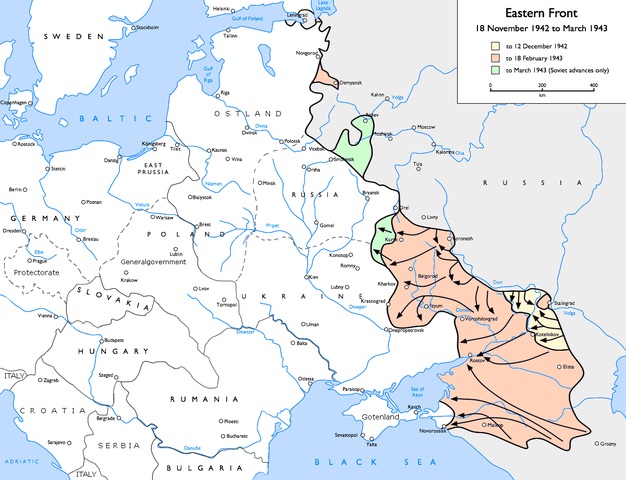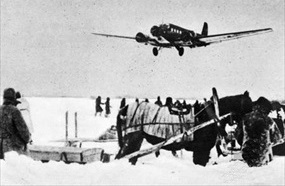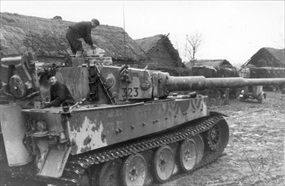FAILED OPERATION WINTER STORM DOOMS GERMANS IN STALINGRAD
Southwest of Stalingrad, Soviet Union • December 23, 1941
On this date in 1942 the German Wehrmacht (armed forces) ended Operation Winter Storm (German, Unternehmen Wintergewitter), the 11‑day attempt by German Army Group Don, a new formation commanded by Field Marshal Erich von Manstein, to break the Soviet envelopment of Gen. Friedrich Paulus’ German Sixth Army during the Battle of Stalingrad (August 23, 1942, to February 2, 1943). Army Group Don included units already on the Eastern Front: the Sixth Army trapped since November 23, 1942, in and around Stalingrad (today’s Volgograd), Col. Gen. Hermann Hoth’s Fourth Panzer Army, which led the drive to relieve the trapped Axis armies, and remnants of the mauled Third and Fourth Romanian Armies.
When Winter Storm kicked off on December 12, 1942, the German relief column made rapid progress for the first 2 days. Manstein’s objective was straightforward: break through the surrounding Soviet siege lines, reach the Sixth Army, then evacuate Paulus’ command. The combined force (rescuers and rescued) would fall back to a more defensible position west of the Stalingrad pocket. But Adolf Hitler, the overall commander in chief of the Wehrmacht, envisioned the German rescue corridor as a permanent resupply and reinforcement route to Stalingrad, enabling Paulus and his men to stay put. (Hitler was loathe to give up the important industrial city and river and rail terminus on the Volga River named for his archenemy.)
Paulus insisted that his army was low on food, transportation, fuel, winter gear, and ammunition and too exhausted to break out; instead, how about an air bridge by the Luftwaffe parachute-dropping the necessary supplies to resist in place? Luftwaffe chief Hermann Goering was agreeable, but the aerial effort eventually came up short for myriads of reasons. Meanwhile, the overland relief column, in the face of intense Soviet pressure, freezing temperatures, and blizzard conditions, managed to slog within 25 miles/40 km of Stalingrad by December 22, 1942. But the Sixth Army breakout never materialized: Soviet forces had inserted themselves between the would-be rescuers and Paulus, who did nothing on his own initiative to link up with the approaching relief column. The next day, December 23, a frustrated Manstein called off Winter Storm. Increasing Soviet strength had made Stalingrad’s rescue too expensive in both armor and manpower. On December 24 the Red Army went on the offensive, pushing Hoth’s Fourth Panzer Army spearhead back to its starting point by month’s end. Sadly for Manstein there just weren’t enough combat-effective divisions or reserve units at the field marshal’s disposal to have ever achieved a successful rescue of the German Sixth Army, much less conduct offensive operations elsewhere on the Eastern Front. Besides, Anglo-American landings in North Africa (Operation Torch) would soon have the effect of draining off men and equipment that might otherwise had been available the following month.
Early in February 1943 the 5-month-long Battle of Stalingrad would conclude with the deaths of 150,000 out of an initial 250,000 soldiers trapped in the Stalingrad pocket, many perishing in brutal hand-to-hand street fighting. Some 110,000 survivors, weakened by their injuries, starvation, cold, and disease, would meet certain death in Soviet captivity. (Only about 5,000–6,000 POWs survived to return home.) Liquidation of the trapped men at Stalingrad was a stunning blow to home-front morale and to Hitler’s own plans to liquidate the Soviet Union (Operation Barbarossa). Stalingrad was thus a major turning point in World War II, marking the beginning of the Axis collapse on the Eastern Front as 4.5 million Red Army troops began a cascading series of offensives that engulfed everything before them.
Operation Winter Storm and the Eastern Front, November 1942 to March 1943
 |
Above: Map of the Eastern Front between November 1942 and March 1943. Operation Winter Storm (December 12–23, 1942) took place in the theater shown in tan sandwiched between the coral of Southern Russia. The Stalingrad pocket (coral oval) lies on the right bank of the Volga River.
 |  |
Left: A 3-engine Ju 52 approaches 1 of 7 airfields near Stalingrad. The Luftwaffe’s “air bridge,” which included cargo planes and bombers pressed into service, could not deliver the minimum 700 tons of supplies needed each day by the besieged Germans, Romanians, Italians, Croatians and “voluteer auxiliaries” (Hilfswillige, Soviet POWs and civilians), who numbered around 300,000. The most successful day, December 19, 1942, the Luftwaffe’s Transportgruppen delivered a mere 262 tons in 154 flights. Winter weather conditions, technical failures, heavy Soviet antiaircraft fire, fighter interceptions, and marauding Soviet tanks eventually led to the loss of 488 German aircraft. Some 266 Junkers Ju 52s were destroyed, or one-third of the fleet’s strength on the Eastern Front. The Luftwaffe also lost close to 1,000 highly experienced aircrew before the airlift collapsed with the loss of the last airfield on January 23, 1943. After that there were only intermittent air drops of ammunition and food until the German surrender at Stalingrad in early February 1943.
![]()
Right: A battalion of Panzer VI (Tiger I) heavy tanks, armed with an 88 mm high-velocity gun, was deployed to Field Marshal Manstein’s Army Group Don in an effort to strengthen the German drive to Stalingrad. On December 12, 1942, Hoth’s Fourth Panzer Army’s LVII Panzer Corps began its effort to rescue German forces trapped in the Stalingrad pocket. Despite early gains, the LVII Panzer Corps was only able to come within 30 miles/48 km of the southern edge of Gen. Friedrich Paulus’s Sixth Army front. After a particularly successful Soviet raid on a German-occupied airstrip and destruction of several dozen aircraft being used by the Luftwaffe to resupply forces inside the Stalingrad pocket, Manstein ordered the spearhead panzer corps to go on the defensive. By December 24 the panzer corps—indeed, all of Hoth’s Fourth Panzer Army—was in full retreat. The inability of the rescue column and Paulus’s refusal to attempt a breakout forced Manstein to abandon Operation Winter Storm on December 23, 1942. In just over 5 months the Red Army had liquidated the largest German army ever assembled, after which Hitler’s Third Reich was consigned to fight a defensive war. At Stalingrad Nazi Germany for the first time looked squarely into the face of calamitous defeat.
The Battle for Stalingrad, August 1942 to February 1943
![]()

 History buffs, there is good news! The Daily Chronicles of World War II is now available as an ebook for $4.99 on Amazon.com. Containing a year’s worth of dated entries from this website, the ebook brings the story of this tumultuous era to life in a compelling, authoritative, and succinct manner. Featuring inventive navigation aids, the ebook enables readers to instantly move forward or backward by month and date to different dated entries. Simple and elegant! Click
History buffs, there is good news! The Daily Chronicles of World War II is now available as an ebook for $4.99 on Amazon.com. Containing a year’s worth of dated entries from this website, the ebook brings the story of this tumultuous era to life in a compelling, authoritative, and succinct manner. Featuring inventive navigation aids, the ebook enables readers to instantly move forward or backward by month and date to different dated entries. Simple and elegant! Click 











